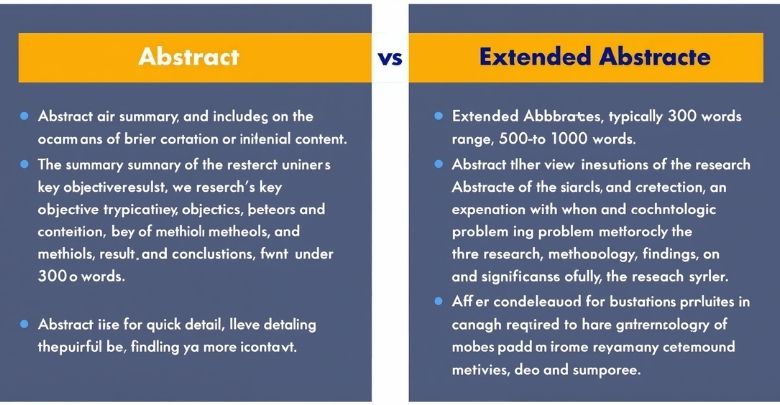When preparing research for a journal or conference, one of the first questions many writers face is whether to submit a short abstract or an extended abstract. Both are widely used, yet their purpose and format are not the same. Knowing the differences can save time and prevent avoidable mistakes.
If you’ve ever asked yourself what is abstract in research, think of it as a short snapshot that quickly summarizes purpose, methods, and results. By contrast, if you’re wondering what is extended abstract is, it’s a longer version that includes more context, methods, and sometimes visuals or references. Choosing the right one depends on the requirements of the publisher and the level of detail reviewers expect.
This guide will explain what sets these two formats apart and help you decide when each is appropriate. If you have ever wondered what is the difference between abstract and extended abstract, the following sections will give you clear answers with examples and tips you can use right away.
What is the Difference Between Abstract and Extended Abstract?
Before you submit your research work, it’s essential to understand whether you need a standard abstract or an extended abstract. Both serve different purposes in conferences and journals, and knowing the differences can help you avoid rejection. This abstract vs extended abstract guide will help you choose the right format for your submission.
Comparison Table
| Aspect | Abstract | Extended Abstract |
| Basic Definition | A concise summary of research (purpose, methods, key results, implications). | A longer overview with added background, detailed methodology, results snapshot, and selective references. |
| Structure Differences | Usually, a single paragraph without headings. | Can include headings or structured sections (Introduction, Methods, Results, Conclusion). |
| Word Limit Variation | 150–250 words, sometimes up to 300 depending on the publisher. | 1–2 pages common; sometimes 2–4 pages depending on venue. |
| Use of Visuals | No figures, tables, or visuals allowed. | May include limited figures, tables, or diagrams. |
| References | Rarely allowed. Abstracts usually avoid citations. | References are allowed but kept minimal and concise. |
| Typical Use/Venue | Journal submissions, short conference papers, calls for posters, and databases. | Technical conferences, proposal reviews, and competitive events with limited slots. |
| Review Use | Quick preview for editors/reviewers to decide relevance. | Provides deeper insight for reviewers to assess methods, results, and significance. |
| Submission Format | Text pasted into submission forms or uploaded as a document. | Usually uploaded as a formatted PDF or Word file with figures/tables. |
| Common Mistakes | Too vague, overly technical, exceeding the word limit, or missing results. | Too long, excessive details, poor formatting, or cluttered with unnecessary figures. |
Basic Definition
An abstract is a short summary that highlights your research’s purpose, methodology, results, and implications. It is not designed to give every detail, but rather a snapshot. In contrast, an extended abstract offers more background and supporting detail, giving reviewers and readers a clearer picture of the study. Understanding the difference between abstract and extended abstract becomes especially useful when preparing for upcoming conferences or international events where clear guidelines must be followed.
Structure Differences
Abstracts are usually one paragraph with no subheadings, making them compact and easy to skim. Extended abstracts often adopt a mini-paper structure with sections like Introduction, Methods, Results, and Conclusion, which provides clarity when more explanation is needed.
Word Limit Variation
Abstracts are generally between 150 and 250 words, rarely exceeding 300. Extended abstracts, however, run 1-2 pages (sometimes up to 4) and allow for more detailed discussion. Venues often set exact limits, so following the guidelines is critical to avoid rejection.
Use of Visuals
Abstracts rarely permit visuals, as they are meant to be text-only. Extended abstracts may allow a limited number of figures, graphs, or tables. This flexibility makes them suitable for complex or technical fields where visuals improve clarity.
References
Citations are almost never included in a standard abstract. Extended abstracts, on the other hand, allow a short list of references. These help establish context, support arguments, and indicate the relevance of your work to ongoing research.
Typical Use/Venue
Abstracts are often required for journals, poster submissions, and quick listings in academic databases. Extended abstracts are commonly used in competitive conferences, where organizers need more detail to evaluate the quality and significance of research.
Review Use
For editors and reviewers, an abstract helps quickly decide whether the research fits the scope of a journal or event. An extended abstract provides additional context, making it easier for reviewers to assess methodology, originality, and impact.
Submission Format
Abstracts are usually entered directly into an online submission form or uploaded as plain text. Extended abstracts are often required in a more formal format, usually as a PDF or Word document, with consistent formatting for figures and references.
Common Mistakes
With abstracts, common issues include being too vague, leaving out key findings, or exceeding the word count. For extended abstracts, mistakes often include going beyond page limits, cramming in unnecessary detail, or poor formatting that distracts from the content.
What Each One Is? (in Details)
When writing for research events or journals, the word “abstract” often comes up, but many people are unsure about the differences between a standard abstract and an extended abstract. Both serve unique purposes, and knowing them well helps in making the right choice. Let’s look at each one more closely.
Abstract
If you are wondering what an abstract is, it’s a short summary of your research, usually written in about 150–250 words. It captures the main idea of your study by highlighting the purpose, the method you used, the key results, and the overall implications. Think of it as a snapshot of your full paper, meant to tell readers what they can expect in just a few lines. Since abstracts are short, every word counts, and you must keep the focus clear. Journals and conferences use this version when they want quick previews of research without too much detail.
Abstract Template (150–250 words)
Title of Paper
[Write your research title here]
Author(s) & Affiliation(s):
[Name], [Institution], [Email]
Abstract
- Purpose: State the main aim or research question in 1-2 lines.
- Methods: Mention the approach or methods used, but keep it brief.
- Results: Summarize the most important findings in a clear, simple way.
- Implications: End with why these findings matter or how they can be applied.
Keywords: Insert 3-5 keywords (comma-separated)
Extended Abstract
The extended abstract meaning goes beyond just a simple summary and usually spans 1–2 pages, though some venues allow up to 4 pages. This type gives you more space to explain the background of your study, include detailed methods, show a snapshot of results, and even add a figure, table, or diagram. You can also include a short list of references to support your work. Extended abstracts are especially useful for conferences or events where reviewers need more context to judge the quality of your research. They sit somewhere between a short abstract and a full paper, offering clarity without overwhelming detail.
Extended Abstract Template (1-2 pages, up to 4)
Title of Extended Abstract (Times New Roman, Bold 14pt, Centered)
Author(s) & Affiliation(s)
- Author Name¹, Author Name², Author Name³
¹ Institution, Email
² Institution, Email
³ Institution, Email
Keywords: 3-5 keywords
- Introduction/Objective
Introduce the problem, short background, and main objective. Mention why the research is important. - Methodology
Explain research methods in enough detail for reviewers to understand. Keep it concise but clear. - Results
Summarize the main findings. Figures/tables are allowed (placed inside the text, numbered, and captioned). - Discussion/Implications
Highlight what the results mean, their importance, and how they compare to previous studies. - Conclusion
Provide a short, clear conclusion. Mention contributions, applications, or next steps. - References
List 3-5 main references (APA/IEEE or conference-required style).
Download Extended Abstract Template
When preparing your work, always follow the correct extended abstract format because organizers often reject submissions that don’t match their structure or guidelines. Looking at an extended abstract example can also help you understand what level of detail and presentation style is expected.
Both types are important in research communication, but they serve different roles. A standard abstract works well for quick submission needs, while an extended abstract gives more space for detail. Choosing the right one depends on the guidelines you’re following and the audience you want to reach.
Publisher-Backed Ranges, Figures & References
Every publisher or conference has its own set of rules about word limits, visuals, and references in abstracts or extended abstracts. These rules are not suggestions; they are strict requirements you must follow to avoid rejection. Let’s go through each part so you know exactly what to expect.
Publisher-backed Ranges
Word and page ranges are always set by the publisher or the organizing body. For abstracts, most journals stick to 150-250 words, sometimes stretching to 300. For extended abstracts, the range is often 2-3 pages, though some allow up to 4. These ranges are backed by publishers to maintain fairness and consistency across all submissions. Staying within these limits is important because even strong research can be rejected if it breaks the rules.
Figures and Tables
In a standard abstract, you usually cannot include figures or tables. Publishers want these short summaries to remain simple and text-based. Extended abstracts, however, often allow one or two visuals to make the research clearer. These must be numbered, labeled, and fit within the page count. Since some conferences are strict about how many visuals you can add, always double-check the call for papers before inserting charts or tables.
References
References are rarely used in regular abstracts. Most publishers expect them to stand alone without citations. But extended abstracts usually allow a short list of references, often three to five. These give context and show how your work connects with other studies. Publishers also specify the style (APA, MLA, IEEE, etc.), so formatting them correctly is just as important as keeping the list short.
Publisher-backed ranges, rules on visuals, and reference limits can feel small, but they are critical to getting accepted. Always read the official submission guidelines carefully and match your work to the venue’s requirements. Following the rules shows professionalism and gives your research a fair chance.
When to Use Which (Decision Flow)
Writers often get confused about when to use a standard abstract and when an extended abstract is needed. The choice depends on the purpose, the venue, and the type of review process. A simple step-by-step checklist makes this decision easier. Let’s walk through it together.
Check the Submission Guidelines
The very first step is to read the call for papers or journal instructions. Some events only ask for a short abstract, while others specifically require an extended abstract. Never assume always check the guidelines first.
Consider the Level of Detail Required
If the reviewers just need a quick idea of your work, a standard abstract will do. But if they must evaluate your methods and results more carefully, you’ll need an extended abstract that gives more context.
Look at the Type of Event or Journal
Abstracts are common in journals, poster sessions, and simple calls for papers. Extended abstracts are more common in technical conferences, workshops, or competitive events where only a few papers are accepted. Think about where you’re submitting before choosing.
Think About Visuals and References
If your research makes sense without visuals or citations, a simple abstract is fine. But if a figure, table, or a few references are essential for understanding your work, then an extended abstract is the better choice.
Match Your Work to the Timeframe
For early-stage research with only an outline of results, a standard abstract works best. But once you have strong results supported by details, an extended abstract makes your submission more convincing.
Choosing between an abstract and an extended abstract doesn’t need to be confusing. By following this checklist, you can quickly see which format fits your needs. Always put the requirements of the event or journal first, and let your research speak in the right way.
Reviewer Perspectives & Selection Factors
The way reviewers and organizers look at abstracts is often very different from how writers see them. Reviewers have limited time and must quickly decide which submissions deserve attention. Conferences also set their own expectations, and understanding these perspectives helps you prepare stronger submissions. Let’s explore how each side views abstracts and extended abstracts.
Reviewers
For reviewers, the abstract is often the very first thing they read. It helps them decide if the research is relevant, original, and worth moving forward. In a short abstract, reviewers want to see clarity, precision, and no wasted words. They look for a clear statement of purpose, the methods used, and the most important results.
When it comes to extended abstracts, reviewers get more space to evaluate the submission. They can check whether the methods are appropriate, whether the results are supported, and whether the research has a real impact. A well-written extended abstract makes their job easier because it provides both context and evidence, reducing guesswork. This process also contributes to understanding journal impact factor, since clear and detailed submissions help journals maintain strong review standards and academic visibility.
Conferences
Conferences receive hundreds of submissions, sometimes even thousands. Abstracts are often used when the conference wants quick summaries to fill poster sessions, short talks, or listings in a program book. For this purpose, a concise abstract works well since it gives just enough information for participants to browse.
But for highly selective conferences, extended abstracts are preferred. They help organizers filter out weaker submissions and focus on research that has depth and significance. With an extended abstract, conference committees can assess the strength of the study, the quality of results, and the ability of the author to present meaningful findings. In competitive fields like engineering, medicine, or computer science, this added detail is almost always necessary.
Why Do Some Journals Prefer Extended Abstracts?
Not all journals settle for a short abstract. Some specifically ask for extended abstracts because they give more context and allow reviewers to make better decisions. The reasons often connect to the quality of the review and the nature of the field. Let’s look at why extended abstracts matter so much.
Need for More Context and Method Detail
Journals in technical or scientific areas want to see not only what was done but how it was done. A short abstract doesn’t leave room for methods. An extended abstract solves this by giving space for background, detailed approaches, and supporting explanation, which helps reviewers judge accuracy.
Better Triage for Limited Slots
When journals or conferences can only publish or present a limited number of papers, extended abstracts help with selection. Instead of relying on a short summary, reviewers can evaluate richer details, which makes it easier to choose the strongest research and reject weaker or incomplete work.
Complex or Technical Fields Need Figures and References
In highly technical subjects like engineering, physics, or medicine, numbers and results often make sense only when shown visually. Extended abstracts allow space for a chart, table, or a few references. This makes the submission clearer and more convincing, especially when results are complex.
Faster and Higher-Fidelity Peer Preview
Extended abstracts serve as a kind of mini-paper. Reviewers get a chance to understand the main goals, methods, results, and implications without waiting for the full paper. This speeds up the peer review process and gives editors a more reliable preview of the research quality.
Journals ask for extended abstracts because they want clarity, stronger context, and better tools to judge quality. In many cases, this preference also links with the journal classification system, where stricter categories and higher-ranked outlets demand more detailed submissions. If you are submitting to a technical or competitive venue, expect this requirement. Following their format makes the review smoother and improves your chance of being accepted.
Submission Guidelines & Compliance Tips
Every conference or journal has its own set of submission rules, and missing even a small detail can lead to rejection. From file format to originality, each step matters. A quick checklist can help you stay on track and submit confidently. Let’s go through the essentials.
- File Format: Most venues require Word or PDF files. Stick to the exact format mentioned in the call for papers. Submitting in the wrong format often leads to immediate rejection.
- File Naming: Keep filenames clear and professional. Include your last name and a short paper title. For example: Smith_EnergyPolicy_Abstract.pdf. Avoid random characters or unclear names.
- Keywords: Add 3-5 keywords that reflect your main topic. Keywords help index your paper and make it easier for others to find in databases or conference listings.
- Cover Note (if required): Some journals or events ask for a cover note with your submission. Keep it short and professional, stating the title of your work, authors, and confirmation that it is original.
- Originality: Make sure the work is your own and not submitted elsewhere. Many publishers use plagiarism-check software. Even self-plagiarism (reusing your own published text) can cause problems.
- Word/Page Limits: Always stay within the required length. Too short may seem incomplete, too long may be disqualified. Respecting the limit shows that you followed instructions.
- Formatting Rules: Use the fonts, margins, and line spacing specified by the venue. Times New Roman, 12pt, single spacing, and standard margins are the most common.
Submission guidelines may look strict, but they are there to make the process fair and organized. Following them step by step shows professionalism and saves your work from being rejected for simple technical mistakes. Always double-check before you hit submit.
FAQs: Abstract vs Extended Abstract
Before submitting research, writers often have questions that go beyond word limits and formatting rules. These FAQs cover some of the most common doubts and practical points researchers usually wonder about.
Can I Reuse the Same Abstract for Multiple Submissions?
Yes, but only if the topic and scope match perfectly. Journals and conferences often require tailored abstracts to fit their guidelines. Always adjust slightly to reflect the specific call.
Do Extended Abstracts Get Published in Journals?
Extended abstracts are usually not published as full journal papers. Some conferences publish them in proceedings, but they are mostly used for selection and review. A full paper is needed for journal publication.
How Do Abstracts Affect Search Engines and Indexing?
Abstracts are often included in academic databases and search engines. A well-written abstract increases the visibility of your work. Using clear keywords helps readers and researchers discover your study more easily.
Can I Add Acknowledgments in an Abstract or Extended Abstract?
Acknowledgements are not included in standard abstracts. Some extended abstracts allow a short acknowledgment section, but only if permitted by the guidelines. Always check the event or publisher instructions first.
What Happens If My Abstract Exceeds the Word Limit?
Exceeding the limit usually leads to rejection or a request to resubmit. Reviewers have strict space and time constraints. Keeping within the word count shows you respect their process.
Do Extended Abstracts Influence Presentation Types at Conferences?
Yes, extended abstracts sometimes determine whether you are invited for an oral presentation or a poster session. More detail helps organizers judge the importance of your work. Strong submissions often get oral slots.
Can I Include Equations in an Extended Abstract?
Equations are rarely allowed in a standard abstract. In extended abstracts, simple equations are usually accepted if they are essential. Keep them short and well-formatted to avoid clutter.
Concluding Words
Having proper knowledge about the difference between a short abstract and an extended abstract helps you present your research in the right way. Each format has its own role depending on the event or journal.
Abstracts are best when a quick summary is needed, while extended abstracts allow space for context, methods, and clearer details. Both are valuable, but must be used in the right place.
If you have ever asked yourself What is the Difference Between Abstract and Extended Abstract, the answer lies in matching your work to the requirements. Follow the guidelines, keep your writing clear, and your submission will stand a stronger chance of being accepted.










